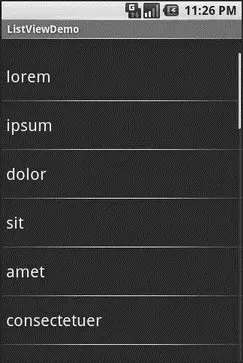However, if your activity is dominated by a single list, you might well consider creating your activity as a subclass of ListActivity, rather than the regular Activitybase class. If your main view is just the list, you do not even need to supply a layout — ListActivitywill construct a full-screen list for you. If you do want to customize the layout, you can, so long as you identify your ListViewas @android:id/list, so ListActivityknows which widget is the main list for the activity.
For example, here is a layout pulled from the Selection/Listsample project. This sample along with all others in this chapter can be found in the Source Code area of http://apress.com.
xmlns:android="http://schemas.android.com/apk/res/android"
android:orientation="vertical"
android:layout_width="fill_parent"
android:layout_height="fill_parent">
android:id="@+id/selection"
android:layout_width="fill_parent"
android:layout_height="wrap_content"/>
android:id="@android:id/list"
android:layout_width="fill_parent"
android:layout_height="fill_parent"
android:drawSelectorOnTop="false"
/>
It is just a list with a label on top to show the current selection.
The Java code to configure the list and connect the list with the label is:
public classListViewDemo extendsListActivity {
TextView selection;
String[] items={"lorem", "ipsum", "dolor", "sit", "amet",
"consectetuer", "adipiscing", "elit", "morbi", "vel",
"ligula", "vitae", "arcu", "aliquet", "mollis",
"etiam", "vel", "erat", "placerat", "ante",
"porttitor", "sodales", "pellentesque", "augue", "purus"};
@Override
publicvoid onCreate(Bundle icicle) {
super. onCreate(icicle);
setContentView(R.layout.main);
setListAdapter( newArrayAdapter( this,
android.R.layout.simple_list_item_1,
items));
selection=(TextView) findViewById(R.id.selection);
}
publicvoid onListItemClick(ListView parent, View v, int position,
long id) {
selection. setText(items[position]);
}
}
With ListActivity, you can set the list adapter via setListAdapter()— in this case, providing an ArrayAdapterwrapping an array of nonsense strings. To find out when the list selection changes, override onListItemClick()and take appropriate steps based on the supplied child view and position (in this case, updating the label with the text for that position).
The results are shown in Figure 8-1.

Figure 8-1. The ListViewDemo sample application
In Android, the Spinneris the equivalent of the drop-down selector you might find in other toolkits (e.g., JComboBoxin Java/Swing). Pressing the center button on the D-pad pops up a selection dialog for the user to choose an item from. You basically get the ability to select from a list without taking up all the screen space of a ListView, at the cost of an extra click or screen tap to make a change.
As with ListView, you provide the adapter for data and child views via setAdapter()and hook in a listener object for selections via setOnItemSelectedListener().
If you want to tailor the view used when displaying the drop-down perspective, you need to configure the adapter, not the Spinnerwidget. Use the setDropDownViewResource()method to supply the resource ID of the view to use.
For example, culled from the Selection/Spinnersample project, here is an XML layout for a simple view with a Spinner:
xmlns:android="http://schemas.android.com/apk/res/android"
android:orientation="vertical"
android:layout_width="fill_parent"
android:layout_height="fill_parent">
android:id="@+id/selection"
android:layout_width="fill_parent"
android:layout_height="wrap_content"
/>
android:layout_width="fill_parent"
android:layout_height="wrap_content"
android:drawSelectorOnTop="true"
/>
This is the same view as shown in the previous section, just with a Spinnerinstead of a ListView. The Spinnerproperty android:drawSelectorOnTopcontrols whether the arrows are drawn on the selector button on the right side of the SpinnerUI.
To populate and use the Spinner, we need some Java code:
public classSpinnerDemo extendsActivity
implementsAdapterView.OnItemSelectedListener {
TextView selection;
String[] items={"lorem", "ipsum", "dolor", "sit", "amet",
"consectetuer", "adipiscing", "elit", "morbi", "vel",
"ligula", "vitae", "arcu", "aliquet", "mollis",
"etiam", "vel", "erat", "placerat", "ante",
"porttitor", "sodales", "pellentesque", "augue", "purus"};
@Override
publicvoid onCreate(Bundle icicle) {
super. onCreate(icicle);
setContentView(R.layout.main);
selection = (TextView) findViewById(R.id.selection);
Spinner spin = (Spinner) findViewById(R.id.spinner);
spin. setOnItemSelectedListener( this);
ArrayAdapter aa = newArrayAdapter( this,
android.R.layout.simple_spinner_item, items);
aa. setDropDownViewResource(
android.R.layout.simple_spinner_dropdown_item);
spin. setAdapter(aa);
}
publicvoid onItemSelected(AdapterView parent,
View v, int position, long id) {
selection. setText(items[position]);
}
publicvoid onNothingSelected(AdapterView parent) {
selection. setText("");
}
}
Here, we attach the activity itself as the selection listener ( spin.setOnItemSelectedListener(this)). This works because the activity implements the OnItemSelectedListenerinterface. We configure the adapter not only with the list of fake words, but also with a specific resource to use for the drop-down view (via aa.setDropDownViewResource()). Also note the use of android.R.layout.simple_spinner_itemas the built-in View for showing items in the spinner itself. Finally, we implement the callbacks required by OnItemSelectedListenerto adjust the selection label based on user input.
Читать дальше












